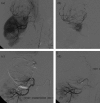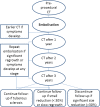Patterns of renal angiomyolipoma regression post embolisation on medium- to long-term follow-up
- PMID: 23392196
- PMCID: PMC3635789
- DOI: 10.1259/bjr.20120633
Patterns of renal angiomyolipoma regression post embolisation on medium- to long-term follow-up
Abstract
Objective: To assess the patterns of regression of renal angiomyolipoma (AML) post embolisation and report the outcomes related to the use of different embolic materials.
Methods: A retrospective review of all patients who underwent embolisation for renal AML at our institution between January 2004 and April 2012.
Results: 13 patients underwent 16 episodes of embolisation. Coils were used as the primary embolisation material in 10 episodes and microspheres in 6 episodes. The size reduction rate highly correlated on CT follow-up between the two groups, with 25.6% vs 22.7% reduction at 12 months, 27.5% vs 25.1% at 24 months, 35.0% vs 33.0% at 36 months and 35.0% vs 36.8% at 48 months. During follow-up, all tumours reduced in size with one patient requiring subsequent embolisation whose tumour reduced by only 6.5% after 1 year and subsequently exhibited regrowth after 4 years. Two patients presented with rebleeding and underwent repeat embolisation. Our overall retreatment rate (23%) is well within the literature range (up to 37%). None of the patients underwent surgery.
Conclusion: The majority of AML shrinkage occurs within the first year following embolisation and appears to plateau after 3 years, which could have an impact on follow-up strategy. The percentage reduction at 1 year may reflect the long-term effect of embolisation with tumours demonstrating minor size reduction more likely to relapse at long-term follow-up. Embolisation of renal AML produces durable long-term results regardless of the choice of embolic agent.
Advances in knowledge: These findings provide information to guide CT follow-up of renal AML post embolisation.
Figures





References
-
- Soulen MC, Faykus MH, Jr, Shlansky-Goldberg RD, Wein AJ, Cope C. Elective embolization for prevention of haemorrhage from renal angiomyolipoma. J Vasc Interv Radiol 1994;5:587–91 - PubMed
Publication types
MeSH terms
LinkOut - more resources
Full Text Sources
Other Literature Sources
Medical
Miscellaneous

